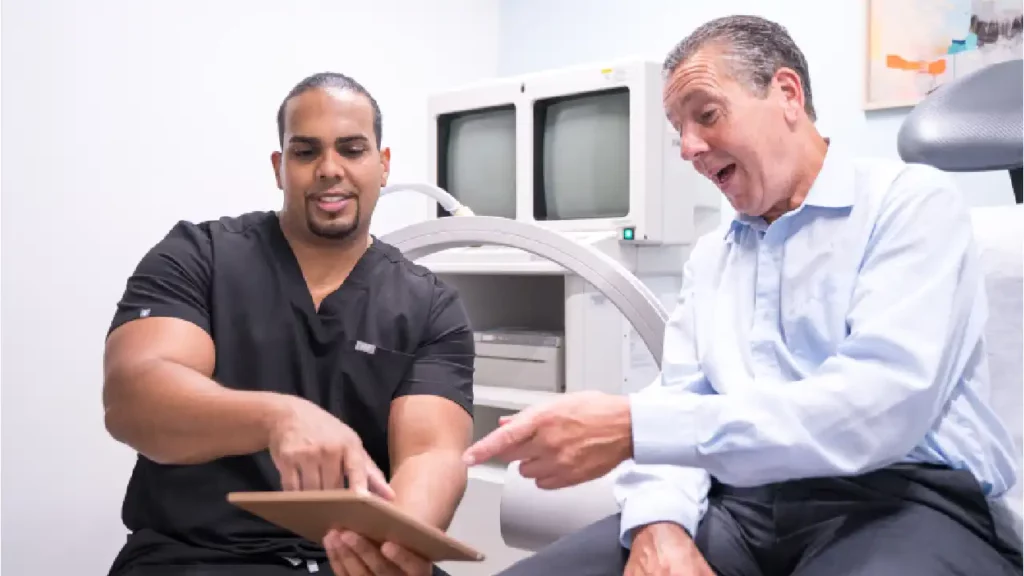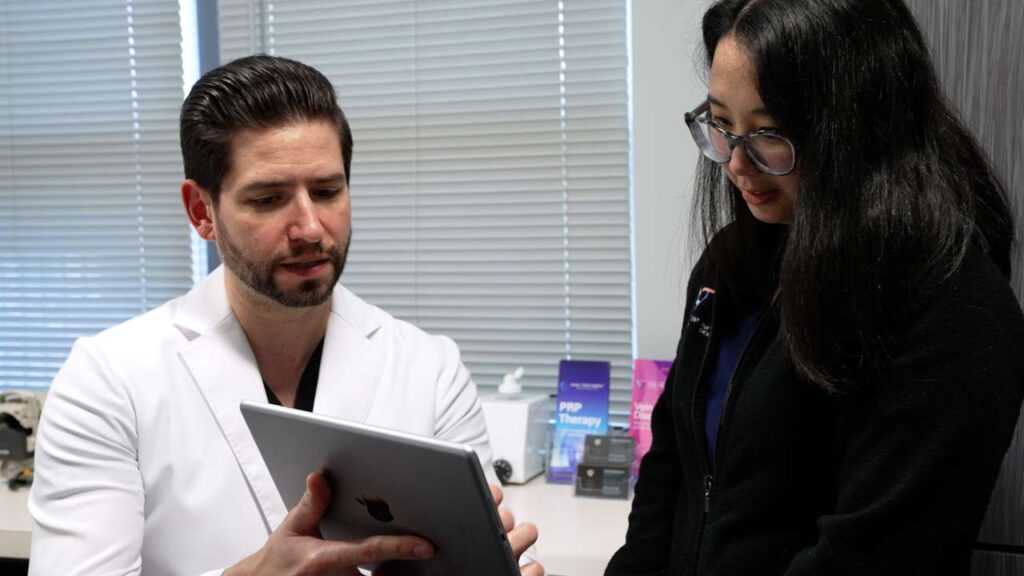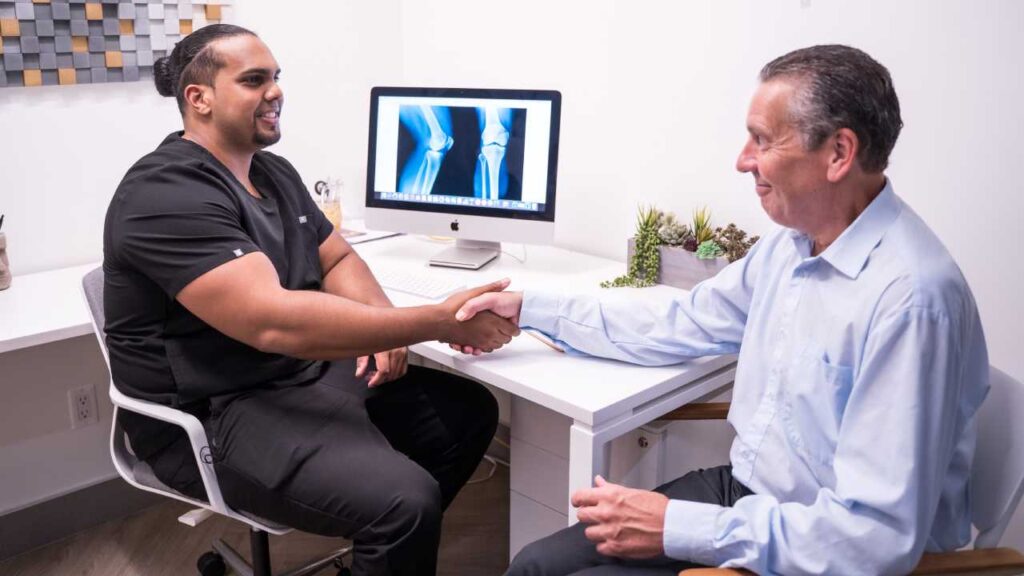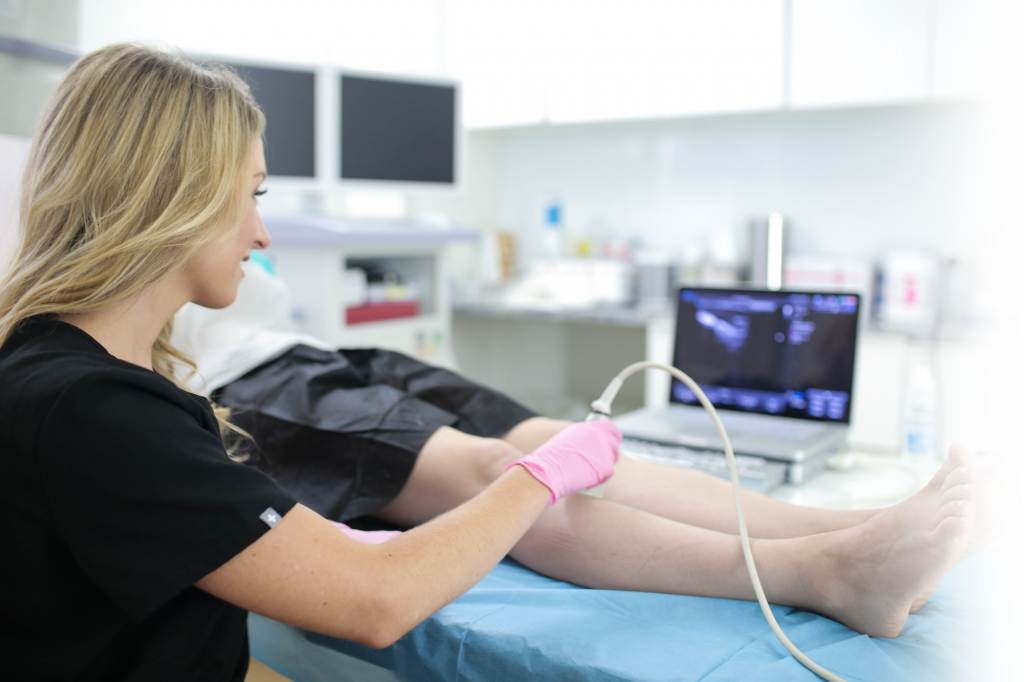What’s the Most Effective Deep Vein Insufficiency Treatment?
Venous insufficiency is a condition in which valves in your veins fail to close, allowing blood to pool in the veins and elevate endovenous pressure. Left untreated, it becomes Chronic Venous Insufficiency (CVI), which generates a range of issues, from bulging varicose veins to clusters of spider veins, and symptoms like leg heaviness, cramping, venous ulcers, hyperpigmentation, and edema.
There are several effective, minimally invasive ways to treat venous insufficiency, and our award-winning vein centers in NJ possess all of the latest treatment devices. The best procedure is one that addresses the underlying issue, not just the surface damage, and it varies based on each patient’s medical history and symptoms. Click HERE to meet with our Harvard-trained vein doctors and determine the right treatment for you. Read on to learn about our innovative options!
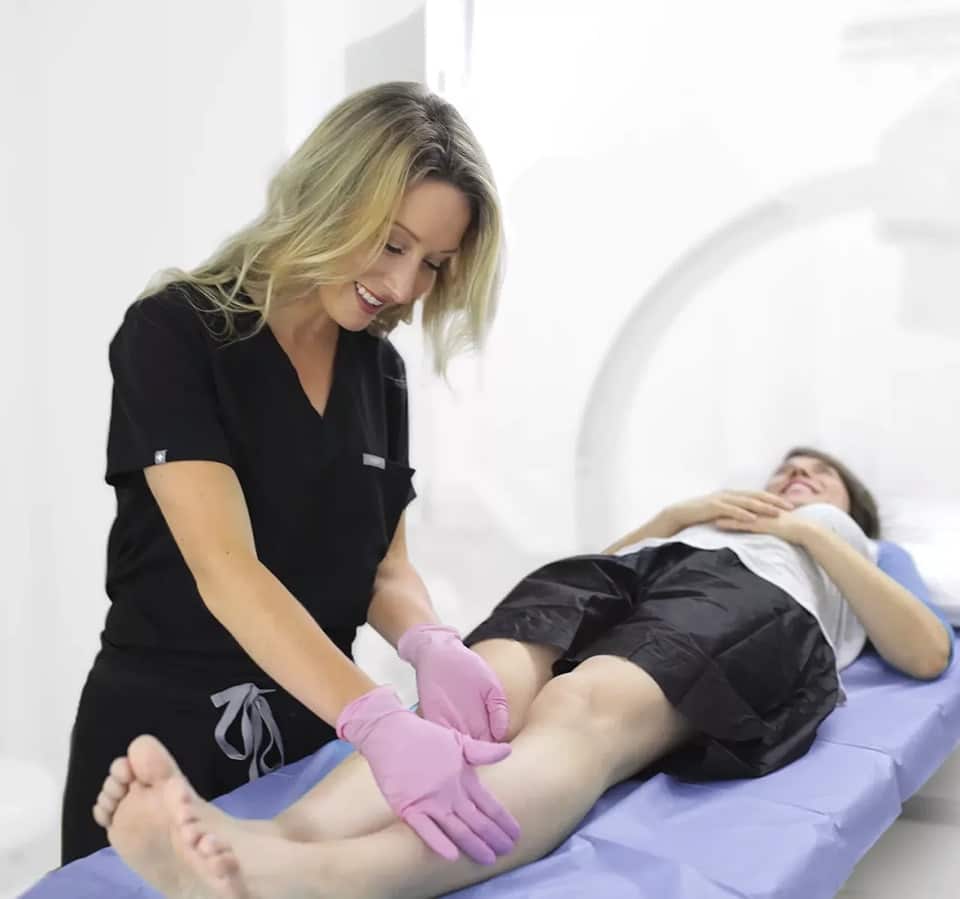
What’s the Most Common Femoral Vein Reflux Treatment?
Venous insufficiency commonly develops in the femoral and saphenous veins in the legs because these veins must work against gravity to pump deoxygenated blood all the way to the heart. In addition to gravitational resistance, vein valves can weaken over time due to aging, obesity, hormonal changes, and inactivity. When valves in your veins fail, blood begins traveling backward through the vein. This generates excess pressure that forces veins to bulge and contort (become varicose) or sprout new dead-end offshoots (spider veins).
It also causes frustrating symptoms like edema, itching, heaviness, cramping, and restlessness in the legs. Successfully treating venous reflux involves closing off the malfunctioning valves deeper in the vein, not just treating the varicose vein or spider vein you see at the surface. Tactics like weight loss, regular exercise, and trying not to sit or stand still for too long might help symptoms, but they won’t resolve the underlying disease. Some of the most common, minimally invasive procedures our NJ vein specialists use are:
- Sclerotherapy– liquid, foam, or pre-mixed foam injected to irritate and close the vein
- Radiofrequency Ablation– thermal energy directed at the vein’s walls to heat and seal it
- Endovenous Laser Ablation– laser fibers that heat the vein and scar it shut
- Vein Adhesives– cyanoacrylate glue injected to close off a faulty vein
- Mechanochemical Ablation– rotating catheter that disrupts the vein physically and medicinally to close it off
Are a Varicose Vein and Insufficiency Healed the Same Way?
Varicose veins and insufficiency are closely related. In fact, Chronic Venous Insufficiency is the cause behind most varicose veins. However, not all vein centers in New Jersey have the Duplex Ultrasound technology to detect CVI or the proper devices to treat it. Some vein centers only treat the visible damage, for instance, using surface lasers to treat spider veins or broken capillaries on the legs or face.
If you have varicose veins, it’s likely you also have valve failure beneath the surface, so you will require an endovenous procedure that addresses the underlying venous insufficiency, to prevent a recurrence of spider veins or varicose veins. Choose board certified vein specialists who are trained in Duplex Ultrasound imaging and minimally invasive procedures to ensure that both your varicose vein and venous insufficiency are addressed. Otherwise, your results will be temporary at best.
Do Varicose Veins = Chronic Venous Insufficiency (Photos)?
While varicose veins are not always caused by CVI, they usually are. However, CVI can also cause other symptoms like spider veins, edema, leg heaviness, fatigue, and restless sensations in your legs when you lie down. Click HERE to see photos of symptoms of Chronic Venous Insufficiency.
As the disease progresses, it can cause venous ulcers, venous stasis dermatitis, and issues like profuse bleeding when you bump or lacerate the skin above the diseased vein. If you’re unsure whether you have varicose veins or Chronic Venous Insufficiency, book an appointment today. Both conditions are very common, particularly in women, and they run in families. Fortunately, there are several quick, non-surgical ways to treat both issues, often with the same procedure.
Is Saphenous Vein Reflux Treatment Guaranteed to Work?
Saphenous vein reflux treatment is remarkably successful, and also easy for the patient. In rare cases where patients’ veins don’t respond to treatment, it’s typically the result of one of two things. 1) The vein center only treated surface damage and didn’t identify and address venous insufficiency, so more vein damage develops. 2) The vein center didn’t possess the right ultrasound technology to pinpoint the source of the issue and position the treatment device correctly.
Our renowned, accredited vein center possesses all of the latest devices to ensure treatment success, and our vein doctors use ultrasound guidance to identify the problem, position the treatment at the source, and also monitor treatment as it travels the length of the vein. We also conduct a thorough physical exam and analyze your medical history prior to treatment to make sure we choose the right procedure. Our 5-star reviews and selection as a Center of Excellence, Real Self Top Doctor, and Patient’s Choice vein center are proof that you’ll be thrilled with our level of care.
What Kind of Doctor Treats Chronic Venous Insufficiency?
There are several types of vascular centers. Some specialize in cosmetic, surface treatments like pulsed-dye lasers. Others are entirely surgical and conduct vein stripping surgery or repair ruptured arteries. But the best doctor for Chronic Venous Insufficiency is one who uses minimally invasive, endovenous ablation techniques.
These procedures treat below the surface, but they’re also non-surgical, so they allow patients to resume their regular activities and avoid hassles like hospitalization, recovery time, and general anesthesia. Cosmetic procedures won’t work for CVI, and surgical procedures are rarely necessary for venous insufficiency. So, visit our minimally invasive New Jersey vein centers for best results!
Is CVI Treatment the Same as Collapsed Vein Treatment?
Collapsed vein treatment, and treatment that intentionally collapses a vein are two different things. Veins can collapse unintentionally, usually from IV drug use, an errant medical injection, or factors like aging and obesity. In most cases, it doesn’t require treatment, but if it remains collapsed, blood will bypass it and travel into viable veins.
Conversely, a doctor can intentionally collapse a vein, if it has a broken valve or varicosity, so that blood is redirected to healthier veins to improve blood flow. This is the intent behind ablation techniques like sclerotherapy, radiofrequency ablation, and vein adhesives, in which a collapsed vein is the desired outcome, not the problem.
Does CVI Treatment Work for Broken Capillaries on Legs?
Chronic Venous Insufficiency treatments can address broken valves and also eradicate the resultant spider veins and varicose veins. However, no one treatment is right for every patient or every type of vein damage. For instance, small spider veins and broken capillaries might respond well to liquid sclerosants that irritate the venous walls, prompting it to close. Larger varicose veins might require a foam sclerosant or a different tactic like radiofrequency to successfully close the vein. Choose a qualified vein specialist with a wealth of options so you receive customized care and optimal results.
Are Varicose Veins, Edema, & Symptoms Fixed by Treating CVI?
CVI causes a host of symptoms and, fortunately, treating CVI can also resolve things like varicose veins, edema, itching, cramping, heaviness, and restlessness in the legs. Treating impaired circulation not only improves blood flow, it also prevents unpleasant symptoms like venous stasis dermatitis and venous stasis ulcers. If your CVI or varicose veins are currently asymptomatic, there’s no guarantee they’ll remain that way. So, book your consultation today to prevent unnecessary complications.
Do You Have to Treat Varicose Veins in Stage 1 for Success?
Varicose veins can be treated at any stage, but like most medical conditions, the earlier you treat them, the better the results. This is particularly true if you have CVI, since valve failure can produce additional spider veins, varicose veins, and bothersome symptoms the longer it goes untreated.
Our doctors will scan the entirety of your venous pathways to look for trouble spots, blood clots, and weakened valves, and close off blood vessels that allow reflux and elevate endovenous pressure. You can repair the visible veins at the surface and ward off future issues by seeking vein care today.
Is Treating CVI, a Varicose Vein, or Burst Vein an Emergency?
While a varicose vein is engorged, it’s not technically a burst vein. It is enlarged by the accumulation of blood within the vein, and it might bulge at the surface of the skin, but it is not ruptured. However, if a rupture occurs, for instance, if the skin above the vein sustains an abrasion or laceration, the bleeding can be hard to control.
Varicose veins warrant an appointment with a vein doctor to prevent complications and restore your skin’s appearance and circulation. But a ruptured vein that won’t stop bleeding is a medical emergency, as is a ruptured artery. So, head to the ER for uncontrolled bleeding from any blood vessel. Visit our renowned vein center in New Jersey for state of the art vein care or to learn more about common issues like CVI and varicose veins.
